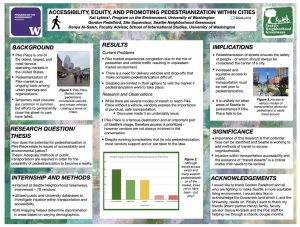ACCESSIBILITY, EQUITY, AND PROMOTING PEDESTRIANIZATION WITHIN CITIES
People are the most critical piece of a city’s success. However, many city plans and designs have failed residents while in the development phase, directing attention to the automobile industry and, in consequence, causing neighborhoods to be inaccessible to pedestrians and making walkability near impossible. While each individual of all backgrounds faces the implications of our society built for cars, minority demographics often bare the brunt of the burden. Ethnic minorities and low-income residents are disproportionately affected by inadequate access to transportation and are subject to urban sprawl developments requiring a car. This study aimed to understand the importance of walkability and accessibility throughout Seattle by identifying bus routes, existing public transportation options, and neighborhood layout concerning demographic. To achieve this task, I utilized the Seattle Department of Transportation bus route map and looked at the locations and increments of time between each bus. I also used public Seattle databases and GIS mapping systems to indicate ethnic minorities and low-income areas. Once those had been found, I overlaid the map with one that displayed neighborhoods that had been historically redlined. The findings show that Seattle continues to be hyper-segregated, and locations of lower income are the least walkable and accessible by public transit. While the city of Seattle and nonprofit organizations are working diligently to combat the discrepancies in accessibility, radical change must be made in order for equality to be reached. Cities in the United States should increasingly be modeled after those in Europe which often ensure walkability and should decreasingly be designed with cars at the center of mind – as people are always the center of a city.
